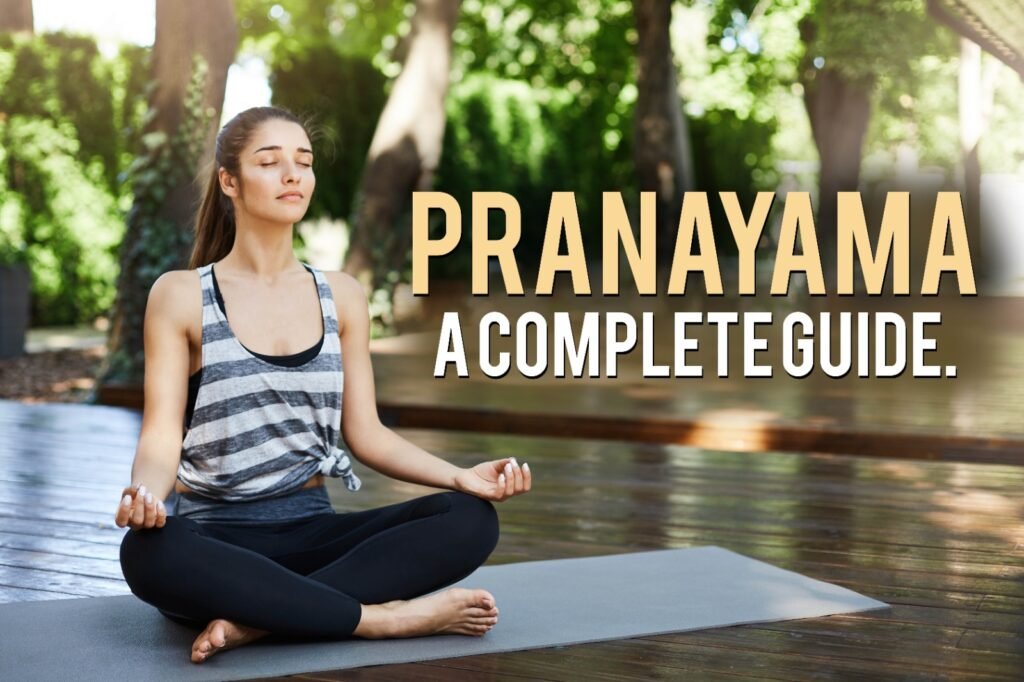Table of Contents
ToggleWhat is Pranayama?
Pranayama is like breathing exercises in yoga. It helps you feel better and calm your mind. It is all about how your breath connects to your energy and health.
Pranayama is a core practice within classical yoga, aiming to regulate and control one’s breath. It plays a key role in achieving physical, mental, and spiritual harmony. As part of the eight limbs of yoga, Pranayama follows ethical principles and physical postures. It enhances the flow of life force (prana), purifies the body, calms the mind, and prepares practitioners for meditation and spiritual growth. By focusing on the breath, Pranayama fosters heightened awareness, facilitating deeper meditation and self-realization, the ultimate goal of classical yoga.
Definition of Pranayama and Its Roots in Yoga Philosophy
Pranayama means controlling your breath. It’s a part of yoga, which is an ancient practice from India. The word “pranayama” comes from two words: “prana” (meaning life energy) and “ayama” (meaning control or expansion). So, pranayama is about managing and expanding the energy that is in your body.
The Profound Importance of Pranayama in Yoga and Meditation
Pranayama is super important in yoga and meditation. It helps you get in touch with your body and mind. By controlling your breath, you can calm your mind and prepare yourself for deep meditation and spiritual growth.
The Connection Between Breath and Life Force Energy
Your breath is closely connected to your life energy. In yoga, they believe this energy flows through your body and affects your physical and mental health. Pranayama is a way to work with this energy, making you healthier and more balanced.
Pranayama Breathing
Pranayama breathing is a part of yoga and meditation that helps you feel better. It is about controlling your breath and it’s good for people of all ages. Let’s look at some simple breathing techniques and their benefits:
Exploring Pranayama Breathing Techniques
Pranayama breathing techniques are like tools that help you feel calm and focused. Here are a few simple techniques to start with:
1. Deep Breathing
Deep breathing means taking slow, deep breaths. It is like giving your body a fresh boost of air. It can make you feel less stressed and more energetic. Find a comfy spot breathe in through your nose and out through your mouth slowly. Focus on each breath.
2. Diaphragmatic Breathing
Diaphragmatic breathing means using a muscle under your lungs to breathe deeply. It helps you relax. Sit comfortably and put one hand on your chest and another on your belly. Breathe in slowly through your nose. feeling your belly rise. Breathe out through your mouth and feel your belly fall. This can help you feel centred and calm.
3. Ujjayi Breath
Ujjayi breath is like making an ocean sound as you breathe. It is used in yoga to stay focused and calm. Sit with your eyes closed. breathe in and out slowly through your nose, making a soft sound in your throat. It helps you stay in the moment and deepen your practice.
Benefits of Pranayama Breathing
Pranayama breathing is good for both your body and mind. When you do these techniques regularly you get lots of benefits:
- Your lungs work better, and your body gets more oxygen.
- You feel less stressed and anxious.
- Your mind is clearer, and you can focus better.
- You become emotionally balanced and feel happier.
- You have more energy.
- You sleep better and feel more relaxed.
- Practising Pranayama breathing can make you healthier and happier.
Pranayama Techniques
Pranayama techniques are different ways to control your breath. They help you stay healthy and feel better. Let’s explore some easy techniques:
1. Kapalabhati
Kapalabhati Pranayama – The Breath of Fire
Kapalabhati is a kind of Pranayama that is like a breath of fire. it is great for your body in many ways.
Benefits of Kapalabhati in Cleansing and Energizing the Body
When you do Kapalabhati, it is like cleaning your body from the inside. It helps you get rid of bad stuff and boosts your energy.
Step-by-step Instructions for Kapalabhati Practice
To do Kapalabhati, sit comfortably and breathe out forcefully through your nose while your belly moves in. Then, let your belly relax, and the inhale will happen naturally. Do this in a rhythmic way. It might take some practice, but it’s worth it.
2. Anulom Vilom (Nadi Shodhana)
Anulom Vilom Pranayama – Balancing the Nadis
Anulom Vilom is a Pranayama that balances the energy channels in your body. it is like making sure your body’s energy flows smoothly.
How Anulom Vilom Enhances Mental Clarity and Focus
When you practice Anulom Vilom, your mind becomes clearer, and you can focus better.
Detailed Guidance on Practicing Anulom Vilom
To do Anulom Vilom, sit comfortably and use your thumb and finger to block one nostril while you breathe in and out through the other. Then switch sides. It’s simple and effective.
3. Bhramari
Bhramari Pranayama – The Humming Bee Breath
Bhramari is a Pranayama that sounds like a humming bee. It is great for reducing stress and anxiety.
Benefits of Bhramari in Reducing Stress and Anxiety
When you do Bhramari, it’s like calming your mind. It’s a natural way to deal with stress and feel more at ease.
Comprehensive Steps for Bhramari Practice
To practice Bhramari, sit comfortably and close your eyes. Then, block your ears with your thumbs, and place your fingers on your forehead. Breathe in through your nose and hum like a bee when you breathe out. It’s a peaceful and relaxing practice.
4. Sheetali
Sheetali Pranayama – Cooling the Body and Mind
Sheetali is a cooling Pranayama. It helps you cool down your body and mind.
The Cooling Effects of Sheetali on the Nervous System
When you do Sheetali, It is like giving your nervous system a refreshing break. It cools you down from the inside.
Practical Instructions for Sheetali Pranayama
To practice Sheetali, sit comfortably and roll your tongue. Breathe in through your mouth and feel the coolness. Then breathe out through your nose. It’s a simple and soothing practice.
5. Bhastrika
Bhastrika Pranayama – The Bellows Breath
Bhastrika is a powerful Pranayama, like the bellows used in a fireplace. It revitalizes and cleanses your body.
How Bhastrika Revitalizes and Cleanses the Body
Bhastrika is like giving your body a good cleaning. It boosts your energy and helps you feel refreshed.
In-depth Guide for Bhastrika Pranayama Practice
To do Bhastrika, sit comfortably and take deep breaths in and out through your nose quickly. It is like a pump, and it can take some practice to get it right. It’s a strong practice, so be gentle with yourself and start slowly.
These Pranayama techniques are simple and effective. They can help you feel better and stay healthy. Try them out and see how they work for you.
Pranayama for Beginners
Preparing for Pranayama Practice
Setting the Right Environment for Pranayama
- Find a quiet and comfortable place where you won’t be disturbed.
- Ensure proper ventilation to have fresh air to breathe.
- Consider using a yoga mat or cushion for a soft surface.
Developing the Proper Mindset for Successful Practice
- Approach your practice with an open and relaxed mindset.
- Let go of stress or worries and focus on the present moment.
- Be patient and kind to yourself as you begin your journey.
A Step-by-Step Beginner’s Guide to Pranayama
Building Awareness of Your Breath and Posture
- Sit or lie down comfortably, with your back straight but not stiff.
- Pay attention to your breath and how it feels in your body.
- Start with regular breathing to become aware of your natural breath rhythm.
Selecting the Appropriate Pranayama Techniques for Beginners
- Begin with simple techniques like deep breathing or diaphragmatic breathing.
- Gradually progress to more advanced techniques as you become more comfortable.
- Choose a technique that aligns with your goals, whether it’s relaxation, energy, or mental clarity.
Ensuring a Safe and Gradual Progression in Practice
- Start with short sessions, like 5-10 minutes, and slowly extend the duration.
- If you feel dizzy or uncomfortable, take a break and resume when you’re ready.
- Consult with a yoga instructor or healthcare professional if you have any concerns or health issues.
Pranayama for beginners is all about creating the right environment, having the right mindset, and taking small steps to enjoy the benefits of this ancient practice.
7 Types of Pranayama
Pranayama is all about controlling your breath to improve your well-being. There are seven main types of Pranayama, and each has its own special way of helping you feel better.
1. Kapalabhati
2. Anulom Vilom (Nadi Shodhana)
3. Bhramari
4. Sheetali
5. Bhastrika
6. Ujjayi
7. Surya Bhedana
Specific Benefits and Effects of Each Pranayama Type
Each of these Pranayama types has its own set of benefits:
- Kapalabhati – cleanses your body and boosts your energy.
- Anulom Vilom – balances your energy and enhances your focus.
- Bhramari – reduces stress and anxiety.
- Sheetali – cools your body and calms your nerves.
- Bhastrika – revitalizes and cleanses.
- Ujjayi – breath helps you stay calm.
- Surya Bhedana – makes you more alert and focused.
By understanding these different types of Pranayama, you can choose the one that suits your needs and begin your journey to feeling better through controlled breathing.
In conclusion – Pranayama is a wonderful practice that can bring positive changes to your life. It is about more than just breathing it’s a way to become healthier and happier. If you are interested in more yoga blogs, visit our blog session at “Hidden Mantra” for further guidance on your yoga journey.








